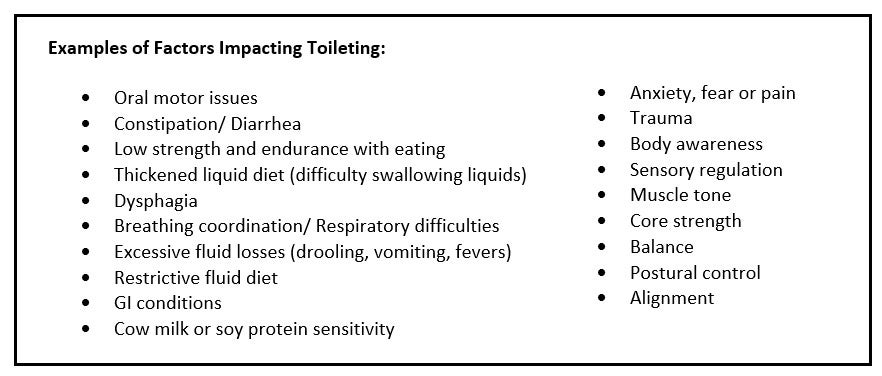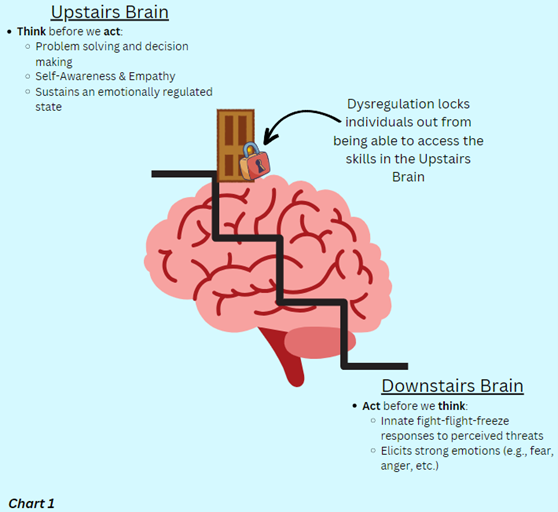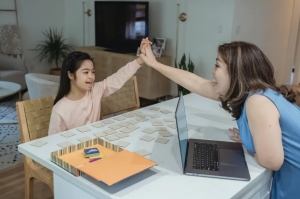
Pediatric Bowel & Bladder Clinic
The Pediatric Bowel & Bladder Clinic at Easterseals takes a multidisciplinary, holistic approach to assessing bowel & bladder issues in children. This is not a potty-training program but looks at the deeper issues that might be holding children and young adults from toileting successfully.
Bowel and bladder problems can be multifaceted. Our clinic works as a team to examine a child’s unique nutrition, sensory system, fine and gross motor systems, communication, and behavioral components together. Working closely with the child’s medical team is also a priority, as specific conditions or medications such as the long-term use of laxatives/stool softeners are assessed.
How to Get Started in the Pediatric Bowel & Bladder Clinic
Contact Intake Coordinator, Mary Beth, at mscholtes@eastersealsdfvr.org, or 630.261.6287.
After the initial intake paperwork, there will be two visits scheduled.
The first visit will consist of a biopsychosocial assessment and medical history screening with a social worker to help frame which disciplines should see the child.
Then in the next visit, a thorough multidisciplinary evaluation will identify various factors contributing to toileting challenges and come up with actionable steps on how to address bowel and bladder difficulties. The team may decide further therapy or a specialist visit is needed and will share resources.
What Makes Our Clinic Different?
Easterseals DuPage & Fox Valley’s multidisciplinary and collaborative approach is at the heart of this clinic. When a family is struggling with toileting or other issues related to bowel and bladder, it can feel isolating. We provide families with support and hope that small changes in different areas can lead to big changes in a child’s bowel and bladder function, and subsequently, in their everyday life.
Our multidisciplinary environment has experience addressing bowel and bladder problems in both neurotypical and neurodiverse populations. Children with developmental disabilities are more prone to constipation and this can impact their daily living in many ways. We provide each child and their family with clarity, tools, and relief in this important area. Our treatment and evaluations are non-invasive and individually tailored to each child’s needs and goals.
Our team approach will ultimately help a child feel more comfortable by identifying the root cause and improving any issues regarding constipation, diarrhea, gas, bloating, bed wetting, and more. By examining the holistic functions of diet, breathing, posture, sensory needs, communication, muscle movement, and anxiety, we can better improve an individual’s daily toileting needs.
What role does each discipline play in this clinic?
Nutrition: A pediatric dietitian will analyze a child’s medical, feeding, and therapy history, past and current diet, and the child’s growth. This examination will uncover what efforts have worked well or have not worked well. Children who have chronic challenges with their boweland bladder tend to have diets that are not optimal, which contributes to how a child feels, learns, grows, sleeps, and interacts in their world. Diet is most often deemed the culprit of bowel issues, and lack of fiber or fluid is the go-to blame. Although these two areas do contribute to constipation, the dietician will closely examine all contributing factors.
Mental Health: A social worker will meet with the child’s caregiver(s) for a biopsychosocial assessment related to the child’s emotional development and history of bladder and bowel issues. Together we will explore how underlying factors and possible stressors have impacted a child’s sense of safety to achieve this milestone. The social worker will also provide support to both the child and their caregiver(s) as the family navigates the clinic.
Speech-Language Pathology: is involved within the program to assess communication barriers to toileting independently and confidently. The speech-language pathologist (SLP) is an expert on the laryngeal mechanism that is responsible for building pressure and stability within the body to allow for passing bowel movements, as well as clearing debris from the airway and producing speech. The SLP will closely examine feeding and swallowing history and may make informed recommendations for comprehensive speech-language pathology services including oral-motor feeding, a consultation with an ENT or other providers.
Occupational Therapy: is focused on improving a person’s ability to complete daily activities and complete toileting effectively. The occupational therapist (OT) will consider the physical components of independent or assisted toileting (getting on/off the toilet, hygiene, managing clothing, as well as donning/doffing diapers/pull-ups, tolerating head position changes that occur during diaper changes, or management of adaptive devices such as catheters or ostomy bags). An OT will examine a child’s body awareness to better identify how different sensations from their environment impact them (either positively or negatively) and explore calming strategies to use should they become dysregulated. In this evaluation, the OT will assess how the child is managing these different skills, and if they are too aware or lack awareness of different sensations during toileting.
Physical Therapy: identifies and addresses motor components that may be contributing to bowel, bladder, and toileting difficulties. The physical therapist will examine a child's overall muscle tone (the amount of tension or resistance to force in the muscles), core strength, and the way they breathe to see if it supports or hinders their ability to eliminate. Balance, postural control, and alignment can impact how relaxed and confident a child is sitting on the toilet, which lends itself to easier elimination. Children who would benefit from biofeedback to address specific pelvic floor muscle issues, such as weakness, spasms, or the muscles not working together in the right way, will be referred to a physical therapist specializing in pelvic floor dysfunction.
























